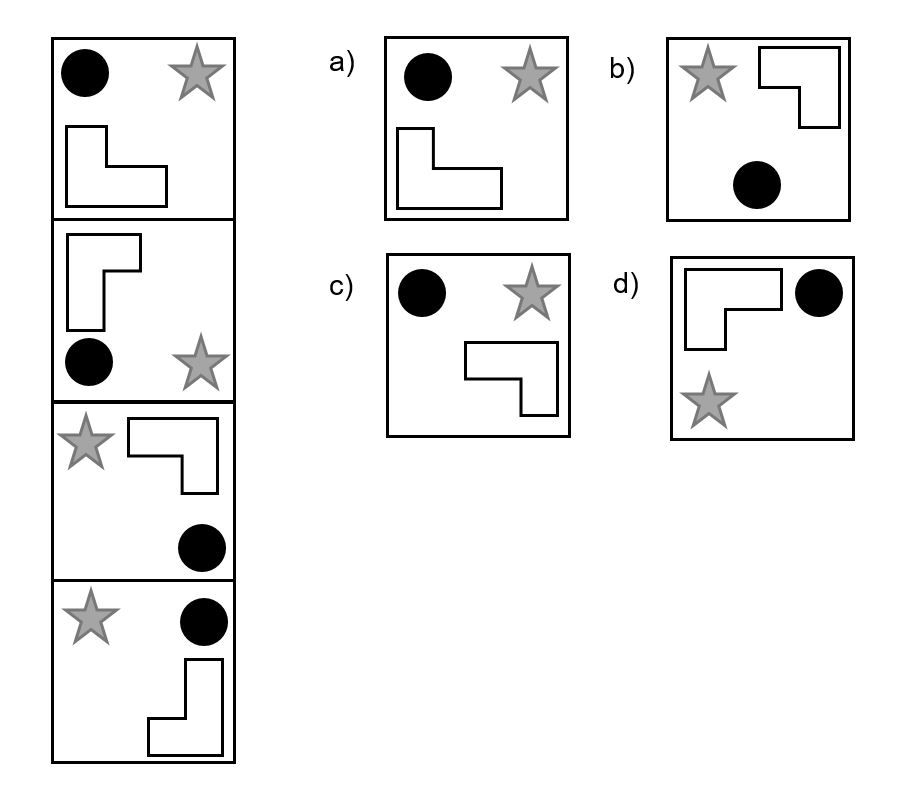Please be aware that the UCAT is undergoing major format changes in 2025. Primarily, the Abstract Reasoning Subtest will no longer be included in the exam. Please be aware of this when preparing for the UCAT and do not practice Abstract Reasoning questions as they are no longer relevant.
Hello and welcome to our article on everything you need to know about the Abstract Reasoning section of the UCAT.
The aim of this article is to provide you with a step-by-step breakdown of the section with some worked examples to give you more of an idea about what to expect. Let’s get started!
As with our other definitive guides – you can read the whole article or jump to the parts you’re most interested in with the Table Of Contents below.
Introduction to Abstract Reasoning
Abstract Reasoning is the fourth and penultimate section of the UCAT. The aim of this section is to assess your ability to identify patterns in sets of shapes and decide which shape comes next in the sequence.
This sounds pretty reasonable, but the test tries to throw you off by also including some irrelevant data that may lead you to make the wrong decision if you’re not careful (sneaky, I know).
With this section, it’s important to note that just because you’ve found one pattern in the shapes, it doesn’t mean that it is the right pattern.
According to the UCAT website, this section measures your ability to ‘change track, critically evaluate and generate hypotheses’.
Abstract Reasoning is sometimes the section of the UCAT that some people struggle with the most.
There are lots of questions in a very short space of time, so you have to be really on it with identifying the right pattern if you’re going to get through everything.
At first, this section can seem the most unfamiliar because there aren’t any words anywhere, you just get given a set of shapes and have to go from there.
If you have an abstract brain you’re really lucky because you’re likely to enjoy this section and do really well in it.
Get support for all 5 UCAT sections with 6med.
Prepare yourself for the whole UCAT with comprehensive resources, an expert preparation course and full access to UCAT.Ninja, available as soon as you sign up.
UCAT.Ninja
UCAT.Ninja

UCAT TUTORING BUNDLE
Get support for all 5 UCAT sections with 6med.
Prepare yourself for the whole UCAT with one-to-one tuition, comprehensive resources, an expert preparation course and full access to UCAT.Ninja, all available as soon as you sign up.
UCAT.Ninja
UCAT.Ninja
Why is Abstract Reasoning included?
Like all the other UCAT sections, Abstract Reasoning is a skill you’ll use throughout your whole career as a doctor or dentist.
It involves the use of your non-verbal and visuo-spatial ability, which is actually a lot more common in Medicine and Dentistry than you’d think. Non-verbal skills are essential for patient interactions as what you don’t say can be just as important as what you do (actions speak louder than words!).
A good visuo-spatial ability will help you with anatomy and visualising parts of the body, especially where there are complicated components inside a small space.
The other application of Abstract Reasoning in Medicine, and dental care, is in diagnosis.
You’re often presented with a large amount of complicated information, some of which is more relevant than others. You’re required to pick out the important bits of information and use them to guide your judgement, which is similar to what you do in the Abstract Reasoning questions.
Making decisions and judgements based on the information you’re given will allow you to make the best decision for the patient, and the one that’s most likely to work the best too.
The third application of this type of reasoning is in research (much like the other sections of the UCAT). The field of research progresses by researchers studying trends and patterns in data and drawing up new hypotheses based on this.
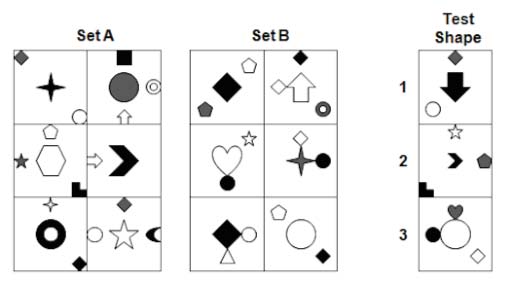
What are the questions in Abstract Reasoning like?
| Number Of Questions | 50 |
| Total Time | 1 minute reading + 12 minutes testing (total 13 minutes) |
| Time Per Question | 14 seconds |
At first glance, 14 seconds doesn’t seem like much time at all, especially in comparison with other sections of the UCAT.
However, Abstract Reasoning questions come in sets, so once you’ve understood the rules of the pattern, you can quickly answer the remaining questions in the set.
Each part of this section provides you with a series of shapes and requires you to answer four questions on it.
There are a number of data sets presented with 50 questions to answer in total. You only have about 14 seconds to answer each question if you’re going to get through them all, so you need to be fairly speedy! (Bare in mind that the number of questions was reduced by 5 in 2022, previous years had 55 questions to answer in 14 minutes).
Luckily, once you’ve figured out the right pattern, answering the questions only takes a few seconds. The problem with this section is that there is a lot of other ‘distracting’ material included in the sets of shapes, to try and throw you off.
But if getting your head around Abstract Reasoning is causing you problems, take a look at our UCAT Tutoring Bundle which covers each section of the Admission Test in-depth.
Abstract Reasoning Question Types
There are four different types of questions you can face in this section.
TYPE #1
You’ll be given two sets called ‘Set A’ and ‘Set B’. The question will ask you which set the shape belongs in (A, B or neither).
TYPE #2
You’ll be given a series of shapes and asked which shape is the next in the sequence.
TYPE #3
You’ll be given a statement about a set of shapes with the shapes shown below the statement. You’ll be asked to select the shape that completes the statement.
TYPE #4
Again, you’ll be given a ‘Set A’ and a ‘Set B’, you’ll then be asked which answer option belongs in one of the sets.
Abstract Reasoning Answer Types
As I’ve mentioned above, each question type has a different way of formatting their answers.
With questions of Type 1 and Type 4, you will have the options of ‘A’, ‘B’ or ‘neither’.
Type 2 and Type 3 will have four shapes that could complete the sequence and you’re expected to choose the correct one.
The key to discovering the correct answer is to come up with a set of questions to ask yourself for each set of shapes. Having a systematic way of looking at each question will help you to eliminate what isn’t the connecting factor.
For example:
- How many shapes are there in each box?
- What colour or colour order are the shapes in?
- How many sides do the shapes have?
- Do the shapes or colours rotate around in an order?
Worked Example Abstract Reasoning Practice Questions & Answers
Abstract Reasoning Practice Question 2
Which is the next shape in the sequence? Get the answer.
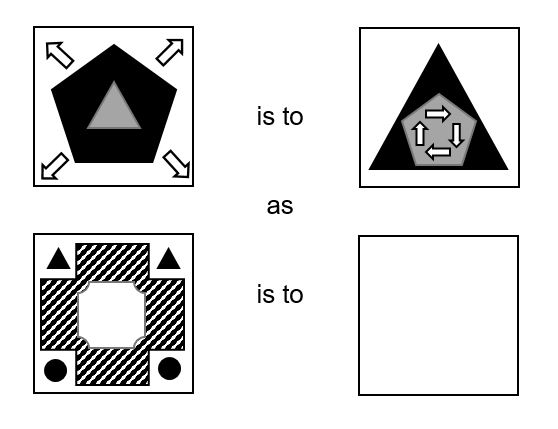
Answer choices:
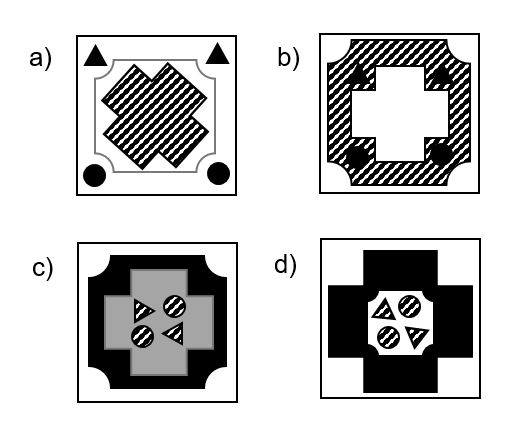
Abstract Reasoning Practice Question 3
Which set does each shape belong to – set A, set B or neither? Get the answer.
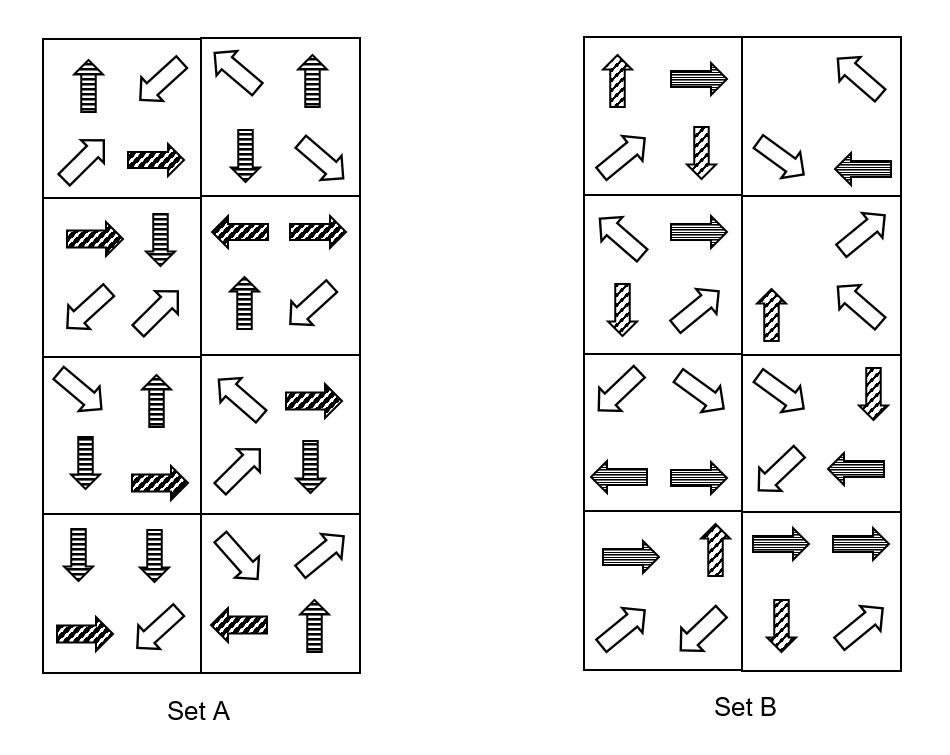
Answer choices:

Answer: A.
The pattern involves the ‘L’ shape only. The L shape moves clockwise as you go down the boxes, and each time is reflected. There is no pattern to the circle and star, they just move randomly to try and distract you.
Therefore, by following this rule, the only logical answer is A.
Answer: C.
In the original pattern, the outer shape (pentagon) and the inner shape (triangle) switch over. This means that the pentagon becomes smaller and moves inside, and the triangle becomes bigger and contains the pentagon. The four arrows that were pointing to the outside of the main box are moved inside the pentagon, and point in a clockwise direction.
The only answer option that follows this pattern is C. You’ll see that the cross from the first box ends up inside the other shape, and the smaller circles and triangles are the innermost shapes that point in a clockwise direction. The change in colours just serves as a distraction from the pattern in the shapes. You’ll find that none of the other answer options follow this pattern.
Answers:
- Set A
- Neither
- Set B
- Neither
Set A – the common theme here is that the vertical arrows have horizontal stripes, the horizontal arrows have diagonal stripes and the diagonal arrows are white.
Set B – there are 2 white diagonal arrows in each box. The vertical arrows have diagonal stripes going up from left to right, and the horizontal arrows have horizontal stripes.
Boost your UCAT score with expert support from 6med.
Prepare yourself for the UCAT with comprehensive resources, an expert preparation course and full access to UCAT.Ninja, available as soon as you sign up.
UCAT Crash Course
UCAT Crash Course

UCAT TUTORING BUNDLE
Learn everything you need to know for the UCAT with 6med.
When you sign up to 6med’s UCAT Tutoring Bundle, you’re getting access to world-class support for medical students who succeeded in the test!
UCAT Crash Course
UCAT Crash Course
How is Abstract Reasoning scored?
For every section of the UCAT, you’ll be given a score between 300 and 900 (300 being the worst, 900 being the best).
This makes 600 the median score for each section. Each question is worth 1 mark, making the section worth 55 points in total. This score is then scaled up to give your final score.
The average score for the Abstract Reasoning section generally sits between 630 and 640.
Each year, this information is published along with all the other test statistics on the UCAT website.
Below is a table showing the average scores for the Abstract Reasoning section over the last 4 years
| Year | Average score for Abstract Reasoning Section |
| 2018 | 637 |
| 2019 | 638 |
| 2020 | 655 |
| 2021 | 651 |

Top Tips for Abstract Reasoning
Abstract Reasoning can be a difficult section if it doesn’t suit your style of thinking. Here is a list of our top tips to help you do well in this section.
1. Know your Time Limits
When you first realise that you only have about 15 seconds to answer each question, it may seem like this could be the most time-pressured part of the test. It often isn’t because you don’t have any reading to do, but it’s useful to know what sort of time pressures you’re working against.
2. Have a set method to go through in your head.
This will save you so much time and make you more comfortable as you go through practice questions.
3. Don’t let the “distractors” do their job!
Remember that there are some shapes and colours there to distract you! Don’t get bogged down if you can’t figure out why certain aspects of the sequence are there, it’s likely that they’re not relevant at all!
4. Flag and move on!
If you’re not sure about an answer, flag the question, move on and come back to it at the end (if you’ve got time). It’s always more worthwhile getting through more questions than getting through only half the section, even if you get that half all right!
5. Take a systematic approach.
There are a number of mnemonics you can learn to remind you of potential patterns: CPR: – Common Colour, Position and Rotation or orientation.
6. Be familiar with patterns.
Take note of any interesting patterns you come across during your practice so you can familiarise yourself with them. it’s always best to start with the simplest box.
If you’re looking for even more UCTA Tips, check out our UCAT Top Tips Guide!
Closing Notes
We hope this guide has given you a good idea of what the Abstract Reasoning section of the UCAT is about.
This is arguably the simplest section of the test, as you’re able to use a set method (asking certain questions) to go through the shapes systematically, unlike with other sections where arguments can be open to interpretation and it’s more difficult to be sure of the correct one.
Don’t forget that Abstract Reasoning is an important part of Medicine and Dentistry, and you’ll improve with time – even after you sit the UCAT, you’ll be using this skill for the rest of your career.
Finally, all of us at 6med want to wish you good luck with your prep and we hope you ace it on test day!
Get support for all 5 UCAT sections with 6med.
Prepare yourself for the whole UCAT with comprehensive resources, an expert preparation course and full access to UCAT.Ninja, available as soon as you sign up.
UCAT.Ninja
UCAT.Ninja

UCAT TUTORING BUNDLE
Get support for all 5 UCAT sections with 6med.
Prepare yourself for the whole UCAT with one-to-one tuition, comprehensive resources, an expert preparation course and full access to UCAT.Ninja, all available as soon as you sign up.
UCAT.Ninja
UCAT.Ninja
